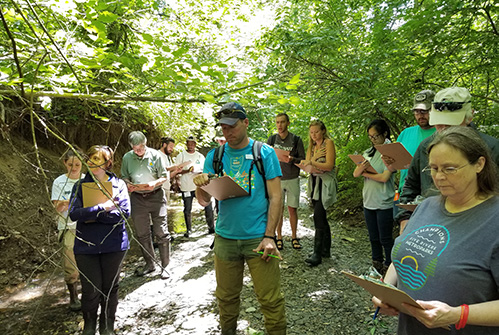The cQHEI (also referred to as Community Stream Habitat Assessment) is a tool that was developed at Ohio EPA in the 1990's as an “easier to use” version of the professional-level QHEI (Qualitative Habitat Evaluation Index) habitat assessment tool. This course provides an opportunity for the public to gain an understanding of the importance of physical stream and floodplain habitats and the many ecological benefits provided by natural streams. The cQHEI is designed to provide a way for citizens to collect data in streams or reaches in hopes to cover areas that might have outdated or little or no habitat data, and to collect a greater pool of data thus expanding the data network. It also providies participants with the techniques required to collect useful and comprehensive data. The cQHEI has already been used in multiple states by a number of volunteer monitoring organizations, including the Indiana “Hoosier” Riverwatch program (http://www.hoosierriverwatch.com).
The focus of our cQHEI training is to foster an appreciation of 1) essential functions of the physical habitat that a creek and its floodplain provides and 2) the way habitat influences the stream biota (e.g., fish and macroinvertebrates) and the stream’s chemical characteristics (e.g. nutrients, etc.). For those interested in monitoring local streams on an ongoing basis, the training is ideal and will provide the details to ensure precision and accuracy. The course will also provide the option for a Level I certification by Ohio EPA and access to the MBI cQHEI database currently under development.
It’s important to note that this course is not for regulatory purposes. If you are assessing habitat to meet EPA’s credible data guidelines, we suggest that you consider the professional level QHEI, also offered by MBI.
Register soon as space is limited. Lunch is included!
Morning: Classroom Instruction (10 AM - 12 PM)
Includes a detailed overview of the cQHEI, including an introduction to Ohio Water Quality Standards (WQS) and biological monitoring, and their relationship to the Citizen QHEI. We will focus on the importance of habitat in your local streams, and how cumulative habitat losses can affect stream quality at watershed and larger scales. This will help to illustrate, for example, how the condition of your local stream can affect conditions such as the harmful algal blooms and hypoxia (loss of oxygen) seen in the Gulf of Mexico, Lake Erie, and the Ohio River.
Lunch and Networking: 12-1:00 PM (Lunch Provided by MBI)
Afternoon: Field Exploration (1-3 PM)
While in the field we will apply what was learned in the classroom. We will review scoring methods, and each participant will practice scoring while trainers provide feedback. The fieldwork will provide practical experience in objective data collection and evaluation.
Recommended Background
No experience needed - just an interest in nature and the desire to protect our aquatic resources. Be prepared to get wet. You can wade in your sneakers, but even better, bring waders or hip boots.
Results
This course will provide trainees with exposure to cQHEI and its uses. Trainees may pursue, if they desire, Level 1 certification with Ohio EPA. If so, MBI will send a certificate of cQHEI course completion to Ohio EPA, who will then register you as Level I cQHEI QDC.

